
“Re-Modernologio” Phase3: Traces of Scenery
February 18 (Sun) ~ March 25 (Sun), 2012 10:00 - 18:00 / Free
JOO Choon Lin
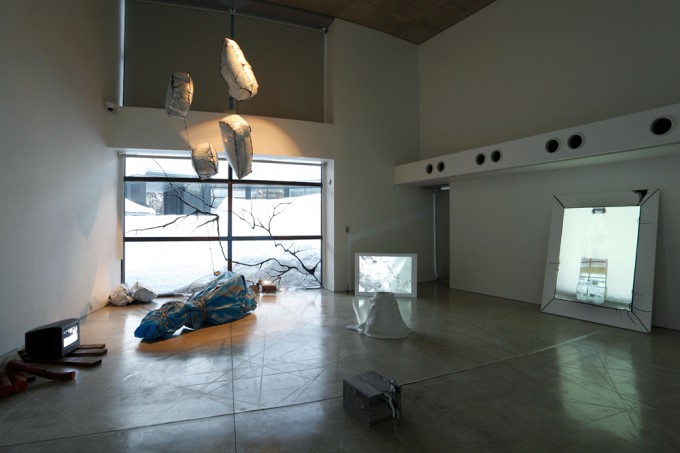
Supersensible Realm, Installation view
Site-Specific Animation on the Idea of Bricolage
HATTORI Hiroyuki
JOO Choon Lin regards her surroundings as a canvas spreading itself before her eyes. She draws pictures directly on different places and arranges varied objects as if attempting intervention into the space, and then creates site-specific animation by shooting a series of stop-motion images. Without hesitation, she smoothly draws pictures on walls and windows using watercolors and so on, takes photos of them, removes them, and repeats the same process over again. A sense of graffiti helps her draw her own characters and phenomenon with motifs of the cheap and pop minutiae such as advertisements and scribbles that attract her attention. Then again, her quick-moving hands create a variety of objects. She processes different surfaces into data through scanning or photography, and prints them on cloths using an ink-jet printer. Using the textures of these surfaces printed in this way, she produces unique, kitschy, deformed imitations of both natural things such as trees and artificial things such as glasses or a tap.
The empathy with the streets and with a kind of DIY attitude that Joo expresses becomes clear when you learn that her birthplace is Singapore. This is a country full of artificial elements. The people there have gained their land by importing soil from neighboring countries, like Malaysia, reclaiming the sea and expanding the land, and most of the abundant trees have been planted. Furthermore, buildings are often raised and re-built within a short span, so this is a place that gets regenerated all the time, rather than building on its history. She has grown up in such a land, and says that from soaking up that artificial environment, so strongly perverted by consumerism, she feels a certain sense of fear of being so influenced by such a materialistic place.
Since her early childhood, she has drawn so much that the instincts of her hands, with the ability to draw quickly anytime and anywhere, has led her directly to her present technique referred to as site-specific animation. Besides, it is said that under the influence of her father, who himself possessed an excellent sense of DIY with the ability to create the things he needed using his own hands, she naturally gained her strong instincts of creating the entire necessaries by her hands, instead of merely living the life of a passive consumer, interested only in the easy purchase of merchandise. The imprints of her unique hands and senses inhabit her objects and drawings. One of her most appealing attributes is that she immediately perceives the characteristics of a given place and introduces into the existing environment her handmade objects, using her strong sense of bricolage and created through the “deformation” of things surrounding us.
She says that when she studied printing at the university, in the process of producing etching using copperplates, she used to change the original copperplates, after printing, into three-dimensional objects by beating them and making them into forms using a hammer. To her this technique of transforming a by-product into different forms matched up with animation greatly. And then, she bought a digital single-lens reflex camera and diligently documented her own prints and objects, as well as the entire production process. This process became a source of amusement and enjoyment, this transformation towards completion, and it has lead her to creating animations where works gradually change, she says.
Come Out and Play!, which was created in Australia and Singapore, is her first piece created using the technique of site-specific animation, which was influenced by the need to use the limited resources available in unusual environments like, for example, in her artist residencies. The technique is about regarding the given place as an unlimited canvas and repeating the process of drawing directly on it, documenting this, erasing that i.e. making the most of the location and developing the work from the specificity of that place.
Joo draws directly on anything in her environment, using everyday commodities and general drawing materials that are easily available such as charcoal and pastel. A different kind of motif, that is images borrowed from advertisements or graffiti that attract her in the city, is combined with her own drawings and modified objects while introducing surrounding views as well, and then making up her own stories. The actually existing scenes are filtered into her animations, including ordinary objects from our daily environment such as an electrical outlet, potted plants, drains and sinks as well as walls. Sometimes even fictional stories are inserted, for example a dinosaur character eats an apartment seen out of a window whose outline she fashions as a chocolate bar.
She adopts comical and cheap characters catching her attention and attempts to intervene into our daily common surroundings. In addition, objects that are created lightly by her unique skill developing from printing techniques, like etching and silkscreen printing, and drawings that appear and change on the surface of water join in the situation. In this way, her site-specific animation unfolds before our eyes in a rhythmic tempo, inserting a comical story into real space.
During her stay in Aomori, she thought about the “circulation of water,” owing to the existence of the thick snow covering the world in white and the grand sea spreading out before her, and at the same time she found the blue-colored tarpaulin attracting her attention in a completely white scenery. Because it includes the extremes of an artificially maintained lifeline versus natural phenomena like a snowfall, the “water” became the main motif within the subject “existing among different spaces,” though in her normal work she draws a pop character to play this role. Furthermore, in a snowy country, a lot of things like signboards, snowplows, cars and plants, are covered with the blue-colored tarpaulin, which was really fresh experience to her. In terms of movie production, the blue color is used as a background for synthesizing images, called blue back. Applying the basic movie technique, she chose the blue-colored tarpaulin as a screen for unfolding animation, and then tried to connect various places and times and make them seem to circulate, by flowing “water” on the screen.
The place where she worked, for both production and exhibition, is the Gallery B, which boasts of a large windowpane facing the Water Terrace. She painted cracks on the windowpane using watercolors with bold lines, as used in comic books because being influenced by the image in her mind of the windowpane breaking into pieces and the water flowing inside. Moreover, she easily created objects representing pieces of glass by sticking sheets of transparent vinyl on each other, equally through deformation like in comic books, so that she documented the way in which the windowpane would break. For the final exhibition, the windowpane was exhibited with the drawings of thoroughly broken glass, and objects of its pieces scattered below it (fig.3). In the gallery, three screens of different sizes were installed. One of them was put in the corner between the front wall and a side wall, at a height near the ceiling, and projected scenes including the blue-colored tarpaulins which she had found in the streets. It was the first time in her life she saw a variety of things covered and protected with the blue-colored tarpaulins in a completely snowy world, and she became obsessed with the sudden appearance of small blue surfaces in a white and silent scenery. Therefore, a lot of scenes including the blue-colored tarpaulins were united with each other, and the look of the undulating sea was inserted on each tarpaulin.
In addition, another series of images was projected on a rather large white panel leaning against the opposite wall, and a drawing of a picture frame, painted directly on the wall using charcoal, fringed the images. This is very much like her to draw it in a plain two-dimensional way like in a comic book, but with a unique touch. In the image, which shows a door of the room where she stayed during her residency, a cloth printed with a scene of Aomori hanging in the middle of the door became gradually covered with black water and at last bleached out into a totally white color, then faded out. Subsequently, a half-full plastic water bottle also appeared. On the water in the bottle, it was reflected how the windowpane in the gallery looked, like a nested structure: with the window’s cracks, the surface of water was coming out of the chink. After the window broke into pieces and the room got filled with water, the plastic bottle also became full of the black water. Then, quickly, switched to an outside scene in the snow. It ended up with the black rain falling in the snow scene. Like the dinosaur character in Come Out and Play! which connects among different spaces, in this animation “water” makes totally different environments meet, just as a medium does.
Finally, on a screen installed on the floor behind the window, the two Chinese characters for “drop” and “fear” made in vinyl by Joo are seen falling in a snowy landscape. Then the surface of water appears in the snowy field, the character for “fear” wavering on the surface. The technique of printing was applied to this artwork: while dropping charcoal into the surface of water from a handmade stencil template, she documented its changing shape through stop motion photography.
Aside from these screens, four 14-inch Braun tube monitors were set on logs that were carried from a different place inside Aomori Contemporary Art Centre, with her handmade logs made from printed cloth scattered around the real logs. On the monitors, there were monotonously projected images of the way in which the handmade logs moved like living things or how textures of the logs were printed from a printer.
In my opinion based on my observation of Joo’s creation process for these three months, it is to her great advantage to have the good grace to be able to quickly surmise the intricacies of environment, and to master the technique of creatively intervening in any environment, using only her own universal skills and sense of DIY. That is to say, she uses both general drawing materials easily available at any place and ordinary things found in the specific town, and also makes the most of its surrounding natural scenery unconsciously. She then connects all the dots by making her handmade motifs cross boundaries freely, and so she composes a series of stories, which take on local characteristics. It is comical and amusing site-specific animation, full of her senses of bricolage that inspires a relaxing and refreshing laugh.

Supersensible Realm
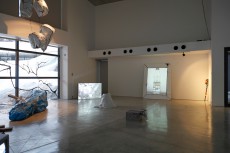
Supersensible Realm
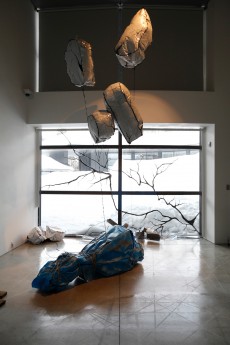
Supersensible Realm
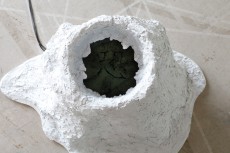
Supersensible Realm
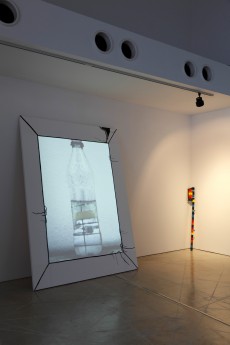
Supersensible Realm

Supersensible Realm

Supersensible Realm
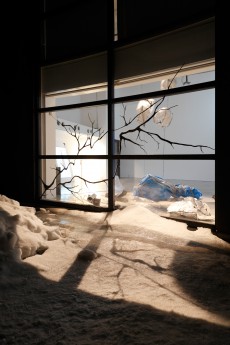
Supersensible Realm , Installation view from outside
「再考現学 / Re-Modernologio」pahse3:痕跡の風景
2012年2月18日(土)~3月25日(日) 10:00 - 18:00/無料
air2011-4ja
ジュー・チュンリン
JOO Choon Lin

《Supersensible Realm(超感覚域)》全景
ブリコラージュ志向のサイトスペシフィック・アニメーション
服部浩之
ジュー・チュンリンは眼前にひろがる環境そのものをキャンバスに見立て、そこに介入するようにダイレクトに絵を描きオブジェを配置し、コマ撮り撮影によりサイトスペシフィックなアニメーションを造形する。水彩絵の具等を用いて壁や窓にも躊躇することなくサクサク描き込み撮影し、またそれを消しては描きを繰り返す。彼女は目に入る広告や落書きなどチープでポップなものをモチーフに独自のキャラクターや現象をグラフィティ感覚でどんどん描いていく。また、素早い手つきで多様なオブジェをつくりだす。様々な素材の表面をスキャニングや写真撮影によりデータ化し、それをインクジェットプリンターで布にプリントしていく。そうやってプリントされた表面のテクスチャーを利用し、木々などの自然物からガラスや水道の蛇口などの人工物 までをデフォルメした独特のキッチュなイミテーションを作成していく。
このようなジューのDIY的でストリートに近い感覚は、その出自を辿るとよく見えてくる。彼女が生まれ育ったシンガポールは、人工的につくりだされた要素に溢れる場所だ。土地は隣国のマレーシアなどから土を輸入し海を埋め立て拡張することで獲得し、豊かな緑も多くは人の手で植樹されている。また建築物は短いスパンでスクラップアンドビルドを繰り返され、歴史の積み重ねというよりは、常に新たに刷新され続ける場所なのだ。そういう土地で育った彼女は、その人工的で消費感覚の強い環境に浸っている一方で、それに小さな恐れを抱いているという。
彼女は幼い頃からとにかくよく絵を描いていたそうで、いつでもどこでも素早く描いてしまう手の感覚が現在のサイトスペシフィック・アニメーションといえる手法に直結していると思う。また、身の回りにあるもので生活に必要なものをとにかくその手でつくりだしていくDIY感覚に優れた父を見ていた影響もあって、単純に商品を購入して過ごすという受け身の消費生活よりも、必要なものは自分の手でつくり出す感覚が彼女には自然と身に付いたという。その感覚と独特な手の痕跡が彼女の生み出すオブジェやドローイングにはある。場所の特徴を瞬時に察知し、身の回りに転がっているものをデフォルメするように、強いブリコラージュ感覚の手技を活かした造形を既存の環境に挿入してしまうのが彼女の大きな魅力の一面にある。
大学時代には版画を専攻しており、銅板を用いたエッチングをつくる際に、 プリントが終わるとオリジナルの銅板をハンマーで叩いて造形し立体物に変容させたりしていたそうだ。副産物を異なったかたちに転用させていく手法は、アニ メーションに非常にしっくりきたという。また、一眼レフデジタルカメラを購入し、自身の制作していた版画や立体物を制作プロセスも含めて非常にこまめに記 録撮影していたら、それら作品が出来ていく変化する過程自体の面白さに気付き、作品が徐々に変容していくアニメーションを作成するに至ったという。
オーストラリアとシンガポールで作成した≪あそびにいこうよ!≫は、アーティスト・イン・レジデンスなど通常と異なる環境で制作する際に限られた資源でどんな場所でも実現できる方法を考えた結果、与えられた場所を無限のキャンバスのように捉え直接絵を描いては記録し消すという作業を繰り返す、所与の場所をフル活用して発展させるサイトスペシフィック・アニメーションの手法を編み出し実現した最初の作品だ。
ジューは木炭やパステルなどの手軽に入手できる一般的な画材と日用品などで、その街で目につく広告や落書きなどから借用したものをモチーフに彼女独自のドローイングやオブジェを組み合わせ、周囲の風景を借景のように取り入れ、そこに街で見つけたグラフェィティや広告のキャラクターなどのポップなイメージを流用し、独自のストーリーをつくりあげ、空間に直接描いていく。壁面だけでなくコンセントや植木に排水溝やシンクなどの生活空間のありふれたものたちを巧みに取り込み、窓の奥に見えるマンションの輪郭を取り出し板チョコに見立て、怪獣のキャラクターがそれを食べてしまうといった具合にフィクションを挿入することで実際の風景を取り込んでいく。
目に留まるコミカルでチープなキャラクターの採用と、日常的なありふれ た環境への介入、そしてエッチングやシルクスクリーンなどの版画技法を転用して独特の手技で軽快に仕上げられたオブジェや水面に描く生成変化するドローイングなどが絡みあい、現実空間にコミカルな物語を挿入するサイトスペシフィック・アニメーションがテンポよく展開していくのだ。
青森では、世界を白く覆う厚い雪や眼の前に見える大きな海の存在から「水の循環」について考え、同時に真っ白な風景の中で目を惹く青色のブルーシートを発 見した。人工的に整備されたライフラインと、降雪のような自然現象の両極から、「水」というものが、様々な場を接続させる、通常の彼女の作品においては描かれるポップなキャラクターが担う、「空間を媒介する」主要モチーフとして採用された。また、雪国では看板、除雪機、車、植栽と多くのものがブルーシートに覆われており、それが彼女には新鮮だったようだ。映像制作において青色はブルーバックという画像合成用の背景として用いられる。その映像の基本技術を応用しブルーシートをアニメーションを展開するスクリーンに選定し、そこを「水」が流れることで多様な場所や時間を接続させ循環させることを試みた。
制作スタジオ兼展示空間となったのは、水のテラスに面した大きなガラス面を持つギャラリーB だ。窓ガラスがバリバリに割れて水が流れこむというイメージをもっていたため、ガラス窓にひび割れを漫画的な大胆な線を用いて水彩絵の具で描き込み、塩化 ビニルの透明シートを貼り合わせこちらも漫画的にデフォルメした立体的なガラスの破片をあらわすオブジェをサクサクとつくって窓ガラスが割れる様を撮影し た。窓は最終的に派手にガラスが割れた様子が描かれたまま残され、その下にはガラス破片のオブジェが散乱している。室内には3つのサイズが異なるスクリーンが設置されている。ひとつは、入口正面の壁とその側壁にまたがるコーナーの天井付近の高い位置に設置されており、ジューが発見したブルーシートのある風景が映し出されている。彼女にとって真っ白な雪の世界で様々なものがブルーシートに覆われ保護されている状況は、これまでの生活では経験がなかったもので、白い静かな風景に小さな青い面が突如出現する様子を面白く思い、ブルーシートのある風景を多数つなげていき、各シートにゆらめく海の様子を挿入していった。
また、向かいの壁に立てかけた白い大きめのパネルにも映像を投影しており、 そこには映像を縁取る額縁のような絵を直接木炭で描いていく。これも独特なタッチでマンガ風に平面的に描いてしまうのが彼女らしい。画面には、レジデンスの彼女の部屋のドアが映し出され、その中央に掛けられた青森の風景をプリントした布が、徐々に黒い水に覆われていき、最後は漂白されて真っ白になってフェードアウトした後に、水が半分くらいまで満たされた1本のペットボトルが登場する。そのペットボトルの水には展示室の窓の様子が映し出され、窓が割れ るとその隙間から水面が見えてくるという入れ子構造になっている。そしてその窓がバリバリに砕け室内に水が充満すると、ペットボトルは黒い水で満たされていき、雪の屋外風景に接続される。最後は雪景色に黒い雨が降りそそぐ。ここでは、≪あそびにいこうよ!≫の怪獣のキャラクターが異空間をつなぐように、 「水」がまさに媒体(メディウム)として全く異なる状況を接続させていく。
最後に窓のそばに床置きで設置されたスクリーンには、雪の風景にジューが塩ビシートで自作した「雫」と「恐」という文字が降りそそぎ、次に雪原に水面が出現しその表面に 「恐」の文字がゆらぐ。これは版画の技法を応用したもので、水面に自家製ステンシルの型から木炭を落とし、その変化をストップモーションで捉えたものだ。
スクリーン以外には4台の14インチのブラウン管モニタが、館内他所から持ちこんだ丸太群の上に設置されており、そのまわりにはジューによる布プリントのお手製丸太も散りばめられている。モニタからはジューの手によるイミテーションの丸太が生き物のように動く映像、その丸太のテクスチャーをプリンタから出力する映像などが淡々と上映されている。
これまで約3ヶ月間ジューの創作活動を見てきて、彼女の強みはその状況判断の潔さと、どんな条件の場所でも普遍的に通用する彼女独自のDIY精神と手技による介入法を獲得していることだと感じた。つまり、どこででも手に入る基本的な画材と、その街で発見できる素材を用い、その場所がもつ環境を無意識的な借景などで巧みに活用し、どんな場所をも彼女の造形するモチーフが自由に往来することで接続させてしまい、その空間ならではの物語を構築することだ。そのコミカルでユーモアのあるブリコラージュ感満載のサイトスペシフィックなアニメーションの造形は、脱力感のあるさわやかな笑いを引き出す。

《Supersensible Realm(超感覚域)》

《Supersensible Realm(超感覚域)》

《Supersensible Realm(超感覚域)》

《Supersensible Realm(超感覚域)》

《Supersensible Realm(超感覚域)》

《Supersensible Realm(超感覚域)》

《Supersensible Realm(超感覚域)》

《Supersensible Realm(超感覚域)》外からの風景
